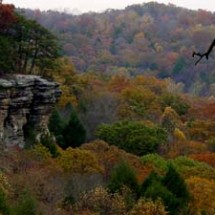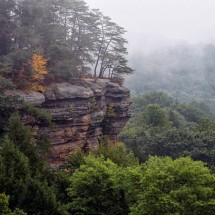Conkle’s Hollow is the most prominent landmark in Hocking Hills. It is visible from miles away given its apex location. Conkle’s Hollow is a gorge that rises 200 feet above the ground and has a maximum width of 100 feet. The façade of the gorge is shaped by erosion and looks like an abstract sculpture. The gorge itself is made from Blackhand sandstone, which has also carved many other recesses, caves and ravines in the area.
most prominent landmark in Hocking Hills. It is visible from miles away given its apex location. Conkle’s Hollow is a gorge that rises 200 feet above the ground and has a maximum width of 100 feet. The façade of the gorge is shaped by erosion and looks like an abstract sculpture. The gorge itself is made from Blackhand sandstone, which has also carved many other recesses, caves and ravines in the area.
Conkle’s Hollow was not formed as the result of an abrupt natural phenomenon such as an earthquake. The gorge is the result of hundreds of millions of years of natural process that started when the entire area was buried under sea. As time went by, the sea evaporated and the sand brought from the mountains got mixed with water, silt, graphite and other minerals. The end result was the creation of a solid structure that rose high and attained a prominent shape thanks to erosion.
A closer inspection of Conkle’s Hollow will reveal that the nature has helped creating unique patterns on the façade. The natural formation looks like as if someone has placed numerous layers of sculpting dough and condensed it to form a unique shape. Iron oxide is present in high amounts in the rock and its interaction with the nature has created hues of red and brown on the façade. The dominant color, however, is still largely stone grey.
It is estimated that Conkle’s Hollow is 350 million years ago though geologists have a varying opinion about this. There is a consensus, however, that the structure is very old and contains some of the earliest evidence of life in Ohio. Excavations have revealed Stone Age artifacts indicating that the site was an important habitat of the people of that era. The formation has long served as an important pilgrimage site for Native Americans as well.
 Another distinctive feature of Conkle’s Hollow is the presence of many waterfalls. The uppermost layer of the rock is a slope that tilts towards the south, providing water an excellent incline that has created small and large waterfalls. Seasonal fluctuations in water flow create breathtaking patterns where one could see a massive drop of water during summer and on rainy days in winter.
Another distinctive feature of Conkle’s Hollow is the presence of many waterfalls. The uppermost layer of the rock is a slope that tilts towards the south, providing water an excellent incline that has created small and large waterfalls. Seasonal fluctuations in water flow create breathtaking patterns where one could see a massive drop of water during summer and on rainy days in winter.
Water flow is reduced during dry months but a small drop can still be observed. Another interesting feature of the waterfalls can be seen in freezing cold winter when the small drop gets frozen. Many make it a point to visit the area during winter to capture snaps of this particular phenomenon.

